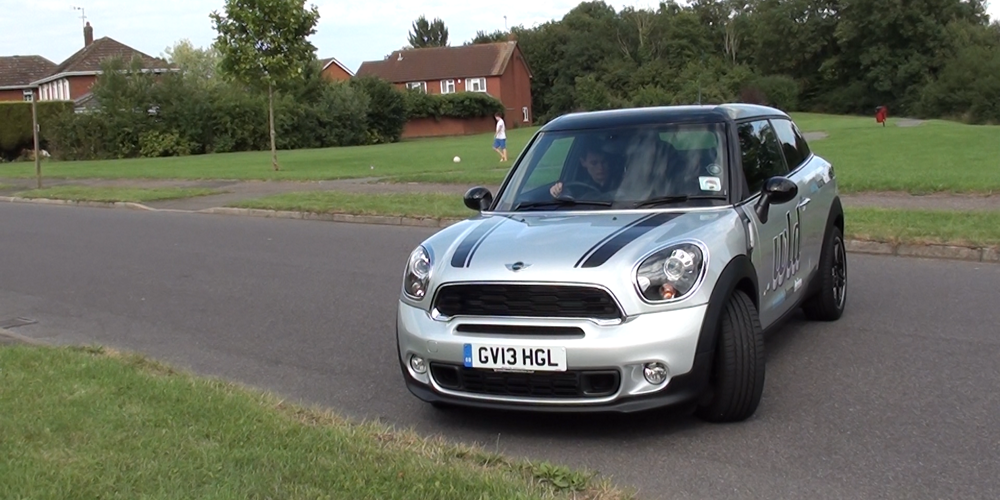
In December 2017, this manoeuvre was removed from the UK driving test - after 82 years!
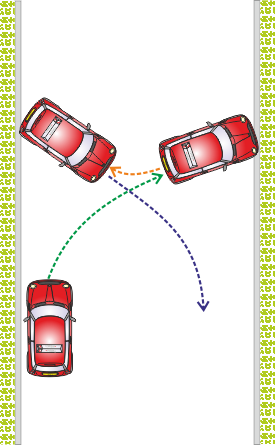 In December 2017, the DVSA dropped this manoeuvre from the UK driving test - after 82 years!
In December 2017, the DVSA dropped this manoeuvre from the UK driving test - after 82 years!
Even though examiners no longer ask you to do this on your driving test, there have been cases where it's been necessary because of a traffic hold-up a blocking the test route. With this in mind, it's worth learning the manoeuvre 'just in case'. But regardless, it can be a valuable skill if there is no other alternative when you need to turn around in the future.
Although it's not in the test, the turn-in-the-road is still in the DVSA recommended syllabus for learning to drive.
The manoeuvre is often referred to as the 'three-point-turn', but this is misleading - you don't have to do it in three moves. The number of moves required will depend on the road width, size and steering of your car – and of course, your skill,
We've kept the three-point-turn in DriverActive because after you have passed your test, you will need the same skills in car parks, garages, tight driveways, petrol stations, and lots of other situations.
This manoeuvre requires the same 'Observation, Control and Accuracy' you have been learning about on earlier manoeuvres.
By perfecting your turn-in-the-road skills, you will be laying the foundation for all your future 'tight space' manoeuvres.
IMPORTANT NOTE: While we suggest that you should learn this manoeuvre you don't need 'pin-point' accuracy, You simply need to be able to steer around the corner and then reverse in a straight line. This should tale no more than 5 minutes to master as long as you do it a the right time. A couple of weeks before your driving test is a good time to learn.
There is no quiz for this lesson.
For over 35 3D briefing videos visit Driving test Success. (Google Play | App Store - appstore practical videos available as an in app purchase in the 4 in 1 kit)

You might not realise it, but if you have been following this programme in sequence and reaching the achievement targets set by your instructor, you already have all the skills you need to easily complete this manoeuvre.
All you have to do now is put them together!
Right turn skills (judging the turn))
In this lesson, you will see how these skills fit into this manoeuvre and just how easy it can be.
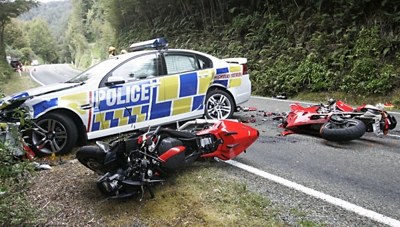
A basic rule for any manoeuvre is that the location must be Safe, Legal and Convenient.
Let's face it, finding a safe place is pretty basic. But not everyone applies basic common sense after they pass their test.
The photo shows a New Zealand police car - the driver was doing a three-point-turn on a bend.
This driver was a 33-year-old licensed police officer, but he still made a fundamental error.
When we talk about safety, safe locations, safe speed and similar stuff in DriverActive, we are not talking about things to do simply to keep within the law or 'drive properly'. We are talking about things you do to stay alive.
We're not here to 'lecture you' - we want you to figure it out for yourself - but not the hard way.
In day-to-day driving, it's often safer, easier and more convenient to find an alternative method if you need to turn around; for example:
Turning right and driving around the block
Using a roundabout
Reversing into a side opening
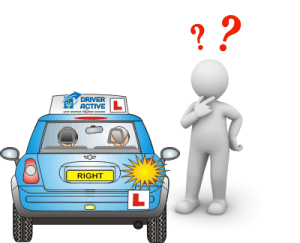
Usually, when moving off from the side of the road, you check mirrors and blind spots and then signal if it would help other road users.
But, on this occasion, you will 'break the rules'!
When turning the car around, a signal is not only unnecessary, it could be misleading or even create a dangerous situation.
We usually give signals to help or warn others.
On this occasion, if anyone is near enough to benefit from a signal, it would not be appropriate to do the manoeuvre.
Also, people can easily misinterpret a signal in this situation.
If you are driving along a road and see a driver parked on the left with a flashing right-turn signal. What are you expecting that driver to do? We guess you will expect the driver to move off and drive along the road ahead.
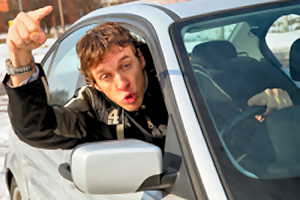 Now, if you are a considerate and 'defensive' driver (more about 'defensive' driving later), you will probably check your mirror, ease off the gas and allow the driver space to move off. Full marks! But not everybody is that sensible or considerate. When seeing a car signalling to move out, some drivers put their foot down to 'beat' the other driver - "No one is pulling out into my space!" - this kind of driving is pretty dumb, but it happens.
Now, if you are a considerate and 'defensive' driver (more about 'defensive' driving later), you will probably check your mirror, ease off the gas and allow the driver space to move off. Full marks! But not everybody is that sensible or considerate. When seeing a car signalling to move out, some drivers put their foot down to 'beat' the other driver - "No one is pulling out into my space!" - this kind of driving is pretty dumb, but it happens.
If you were about to do your turn and, for some reason (despite your proper observation checks), failed to see the dumb driver, you could be in trouble.
So always make sure the road is clear. And, of course, when the road is clear, you won't need a signal because no one will benefit from it!
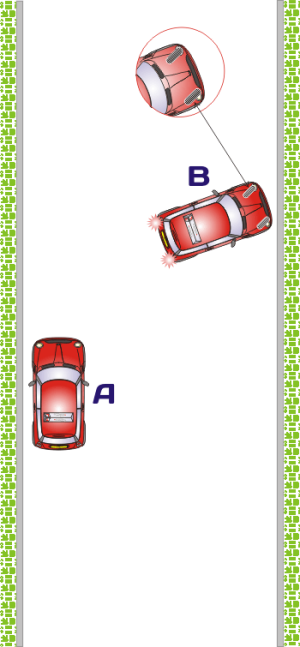
The first leg of the turn requires you to drive from point 'A' to point 'B' (see diagram). During this part of the manoeuvre, you will use the skills you learned in your 'Angle start' lesson.
After making sure it's safe to proceed (by checking all around for traffic and pedestrians), move off very slowly (zimmer frame speed!). Use clutch-control in a manual car or your preferred method of controlling the vehicle at a very low speed in an automatic or electric car.
As soon as the car starts to move, steer to the right until you get 'full lock' (the point where the wheel won't turn anymore).
Keep full lock as you move at a snail's pace. When you are about one metre from the kerb, you will need to steer to the left - your instructor will help you recognise this point, or you can just use trial and error to work it out yourself.
Steering left is to prepare for the reverse part of the manoeuvre (look at the position of the front wheels on the diagram).
Look for other traffic and pedestrians, and be prepared to stop if necessary.
Stop the car about 20/30 centimetres from the kerb being careful not to let the front of the car overhang - there are two reasons for this:
You might startle or inconvenience pedestrians
Some cars have low 'spoilers' at the front - these could easily get caught on a high kerb, damaging the car.
When you stop, it's often a good idea to put on the parking brake to stop the car rolling into the kerb.

When reversing, you need the same control and speed considerations as when driving forward across the road. However, here your observation becomes much more important - simply because there are more places to look.
Make sure you are sitting so you can reverse easily, and then select reverse gear (reverse mode in an electric car).
Next, check for other road users. Although the road was clear when you set off, the situation might have changed.
If the road is clear, you can carry on, but if there are other road users around, you need to decide: "Do I wait and give way, or do I go?"
The answer to this question will depend on the other road users' actions. Remember, during any manoeuvre like this, you are the 'odd one out' and must be prepared to give way if necessary.
Sometimes it will be obvious that other drivers intend to give way - equally, others will be coming through without giving way. However, there will be times when you are uncertain about what the other driver intends to do. On these occasions, it is often helpful to make 'eye-contact'.
When it's safe to proceed, look over your left shoulder and release the handbrake (or footbrake) to move back. It's essential to look behind before you start to move.
If you are in a manual car, you might need your hill-start skills if the road has a steep camber.
Reverse slowly (zimmer frame), steering briskly to the left and occasionally making all-around observation checks as you cross the road.
When you are about halfway across the road, it will help you turn and look over your right shoulder - doing this will allow you to see the kerb and judge your position more easily.
As you turn around, steer briskly to the right to prepare for the final leg of the turn (see the front wheels at point 'C' on the diagram).
Stop about 20/30 centimetres from the kerb, again being careful not to overhang.
Again, putting on the handbrake can be helpful, especially in a manual car.
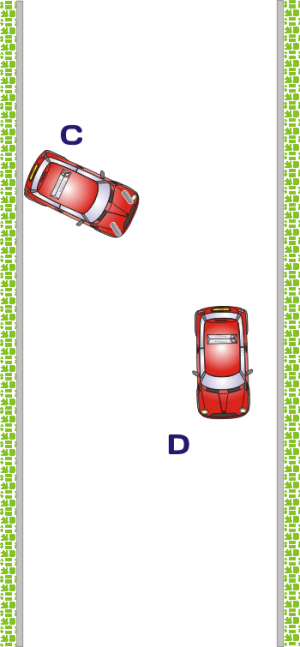
Starting at point 'C', use your 'right turn observation' skills to get you safely across the road to point 'D'.
Remember to eye contact with other road users if you are uncertain.
Letting other road users make their own decisions about what they should do is essential. With this in mind, it is a BAD idea to wave people past.
If you wave to other drivers, their attention will be on you and not the road - plus, there is a possibility that there will be something that you have missed and which is not visible to the other driver (for example, a child on a bicycle).
Allowing others to make their own decisions makes them more likely to look all around and less likely to be in a rush to get past you.
Of course, another reason is that the Driver and Vehicle Standards Agency state that you should only use the methods of signalling outlined in the Highway Code.
When you are sure that it is safe, look to the right (through the driver's door window) and move forward slowly while steering briskly to the right.
It won't be necessary to look at the kerb because you can easily judge whether you are on course by concentrating on your finishing point ('D'). If you think there will not be enough room to get round, stop and repeat the reverse leg.
Whether you intend to stop or continue along the road, check your mirror as the car straightens. If you are stopping, give a signal for anyone who will benefit.
This tip will also help if you have had problems with steering when turning right - or turning anywhere 'tight', for example, some multi-story car park ramps.
As you drive forward on the last leg of the turn, notice what your chin is doing.
It might sound a little strange, but lifting your chin is a sign that you are looking in the wrong place - the front of the car - if you do this, you will struggle with accuracy.
Look out of the driver's window and let your hands follow your eyes, this way, it will be easier to judge the car's position.
